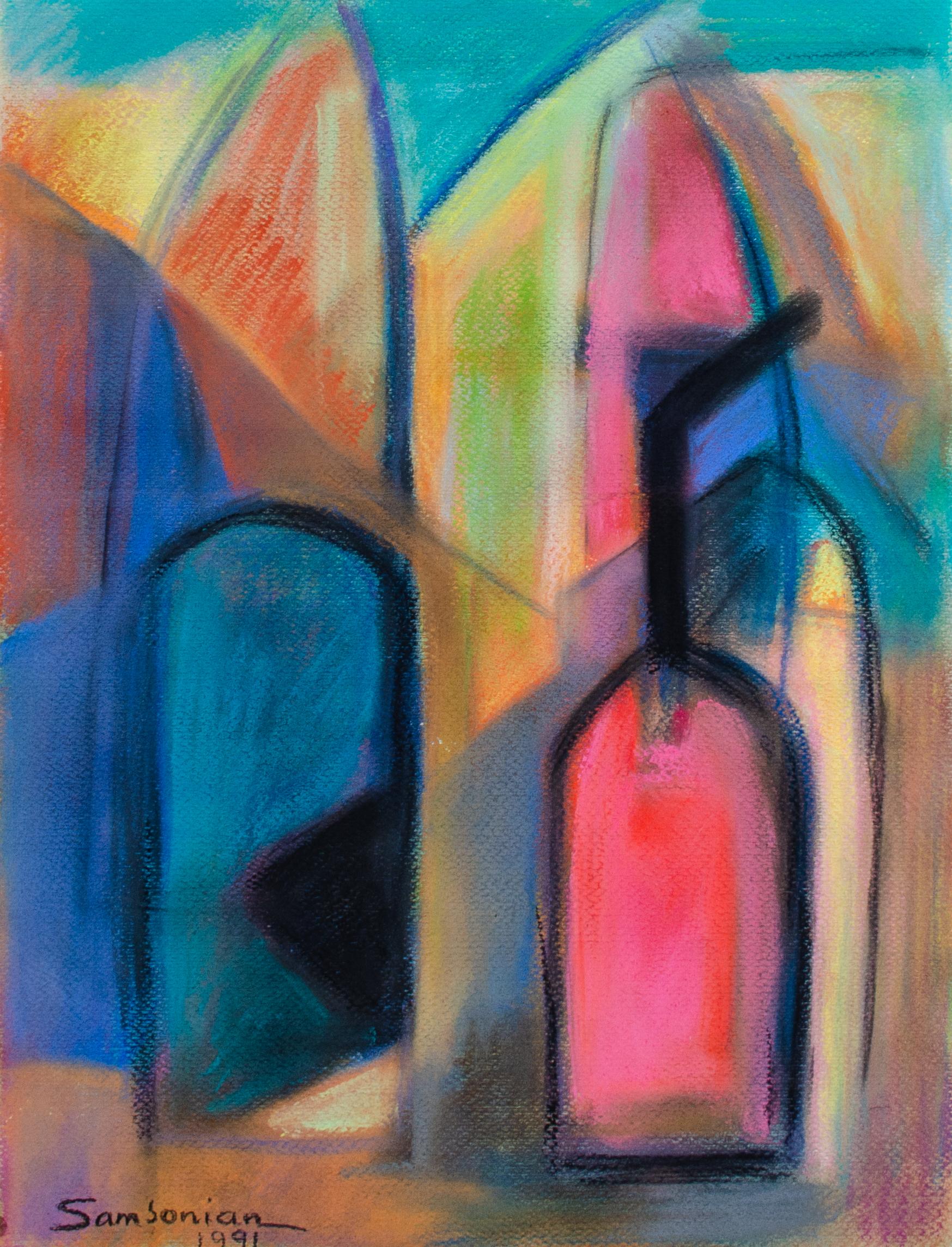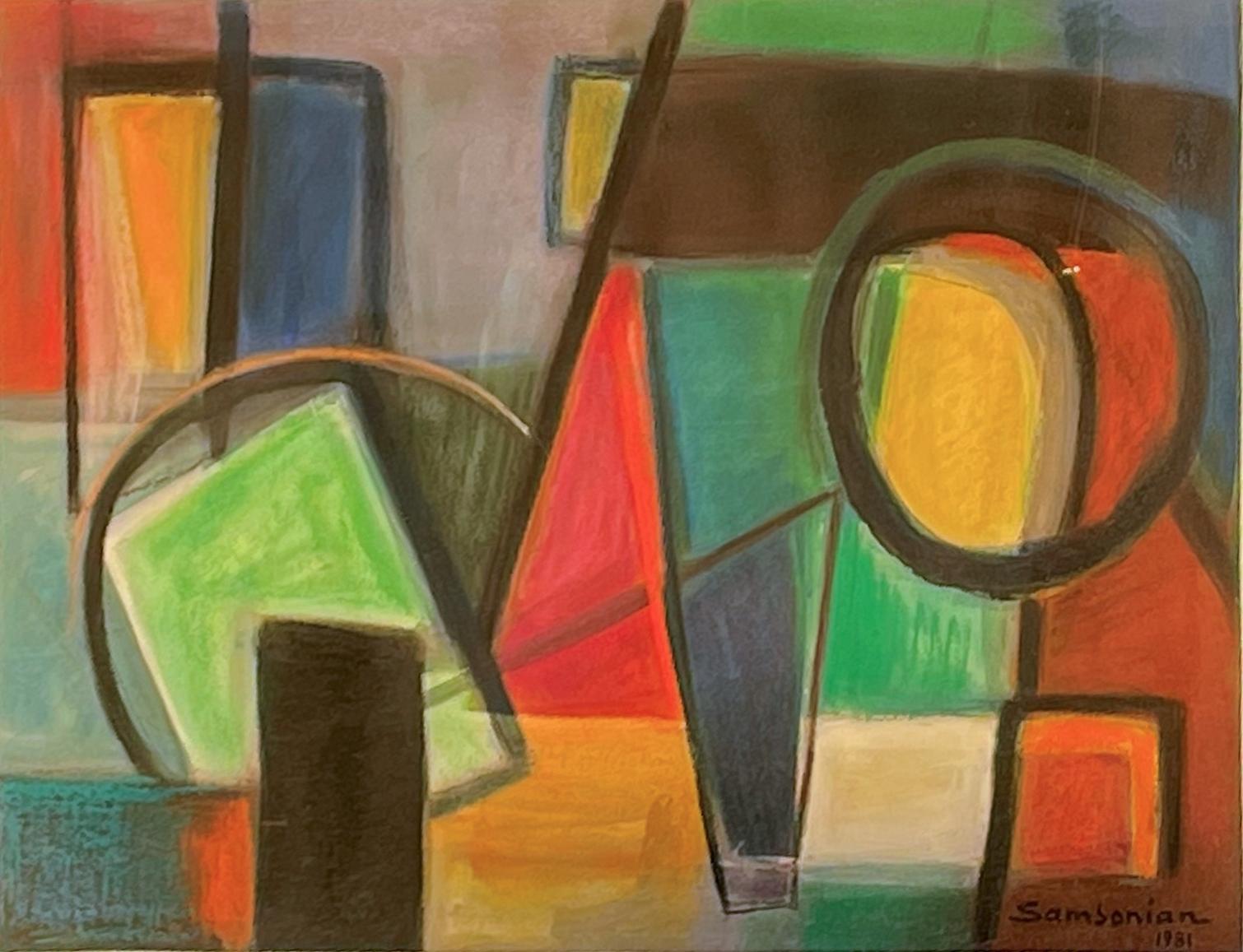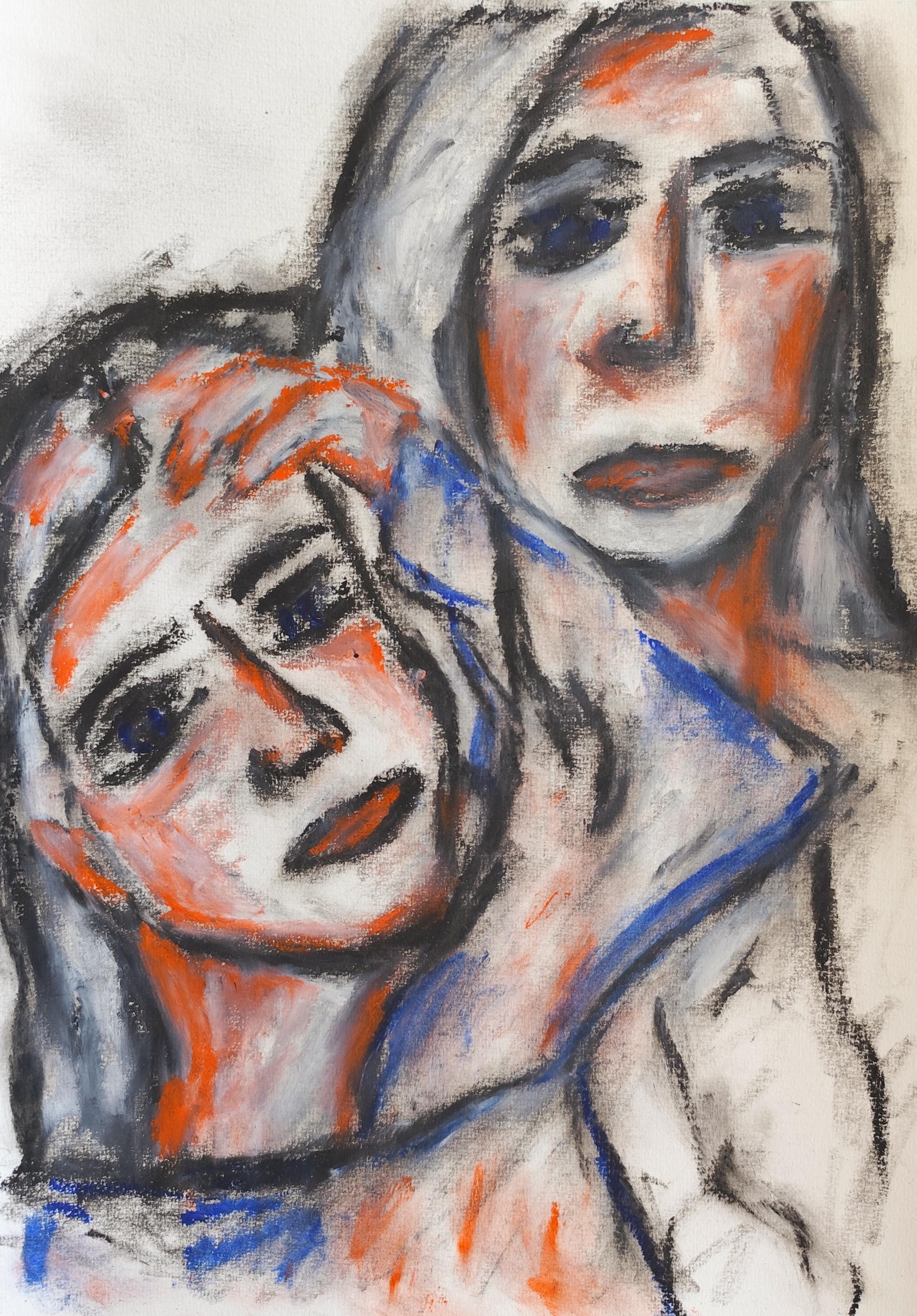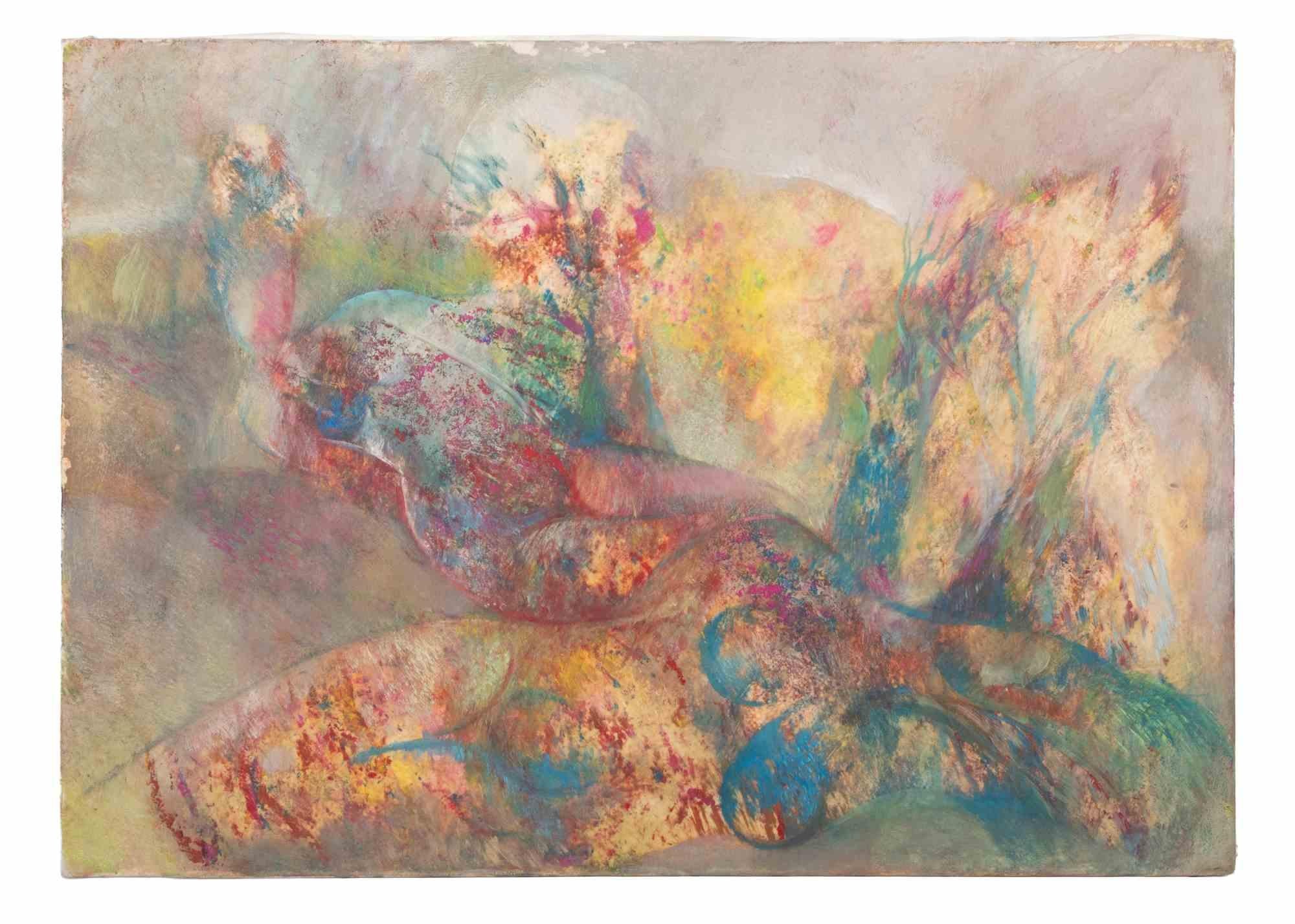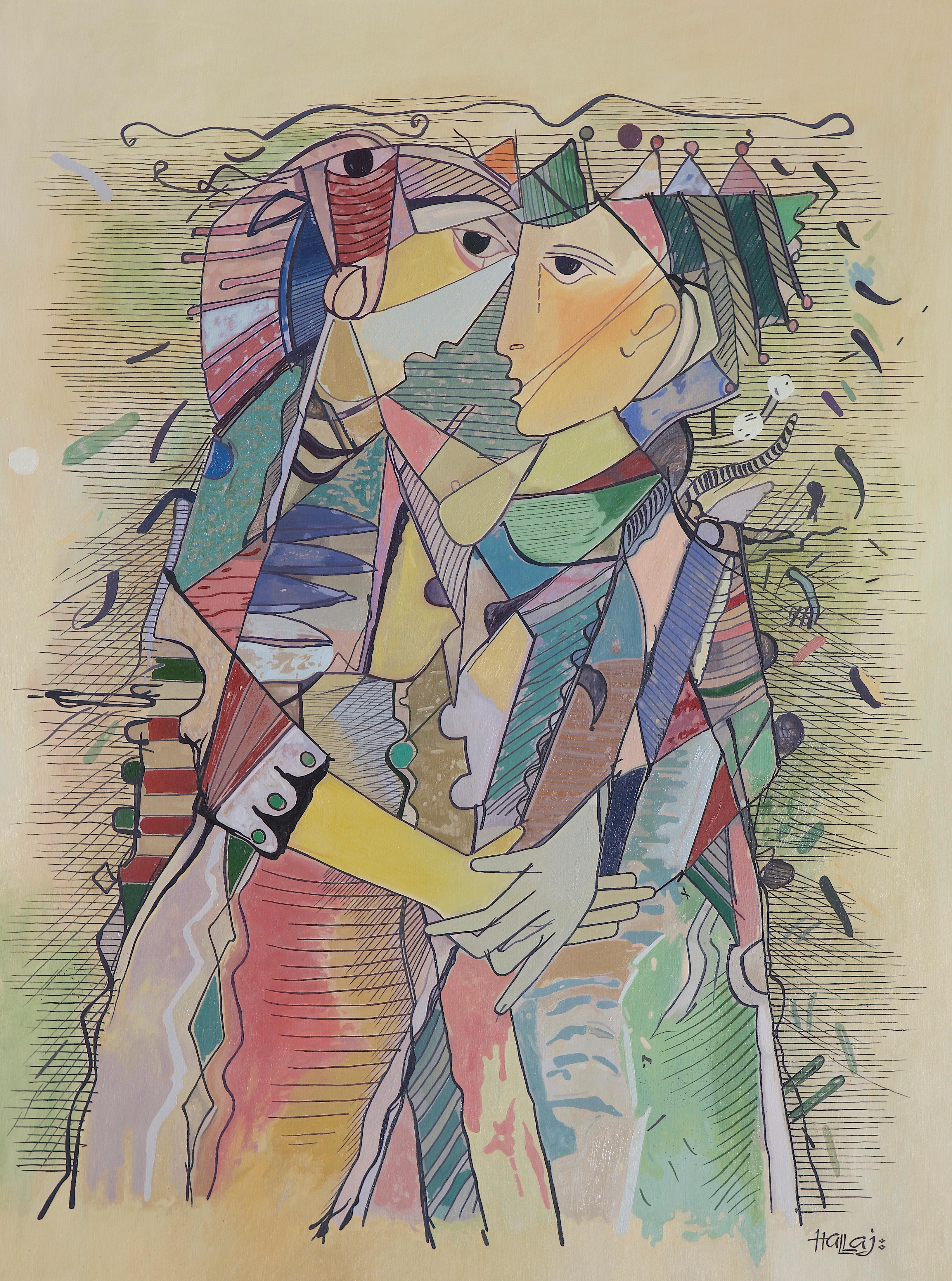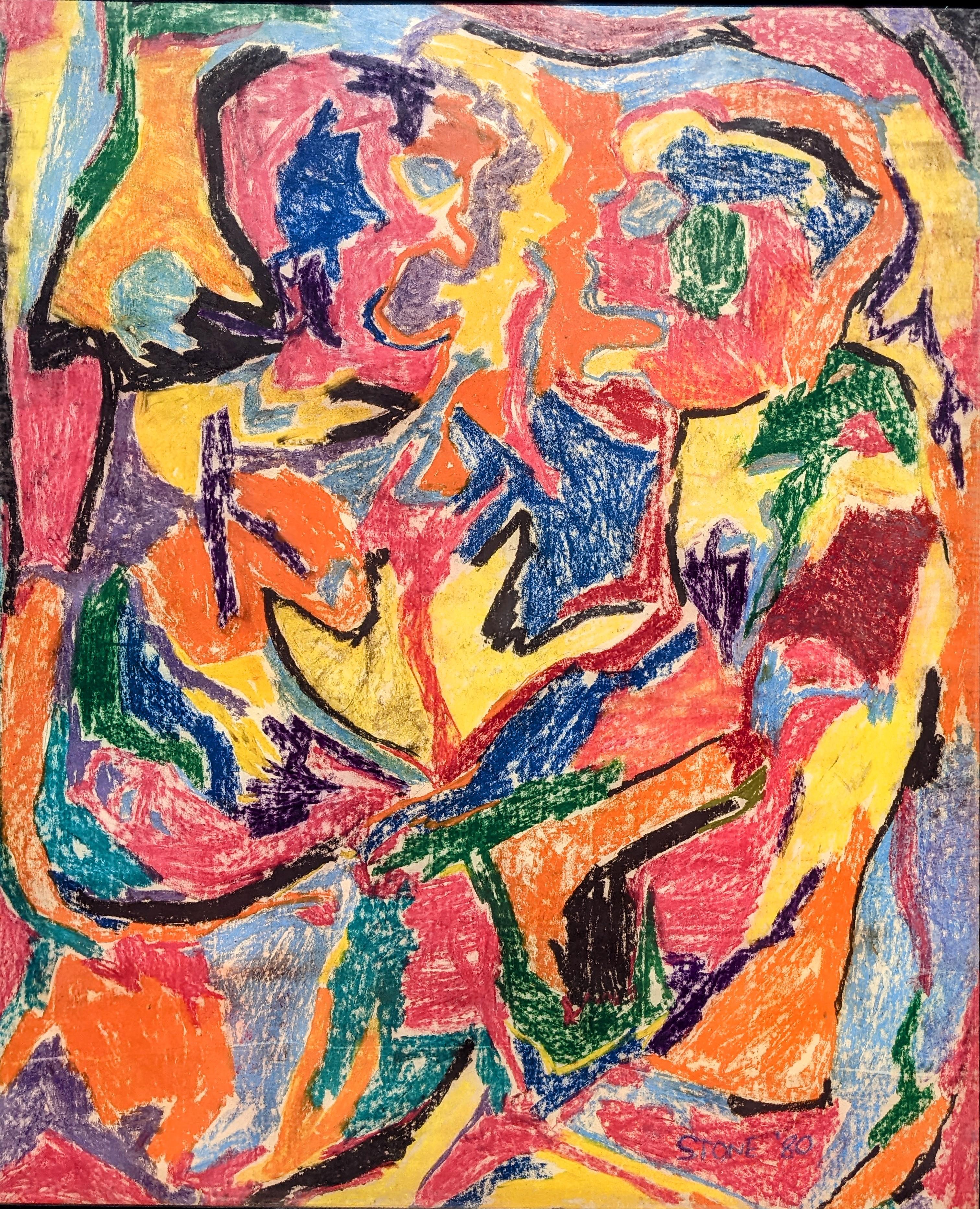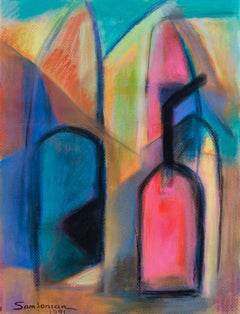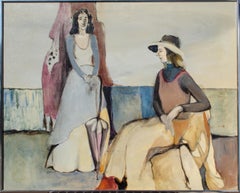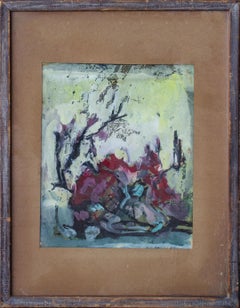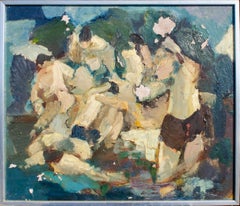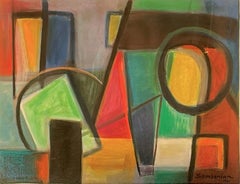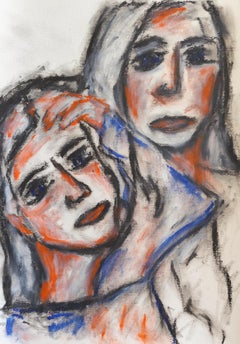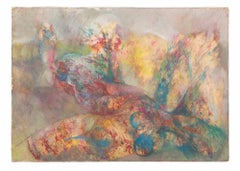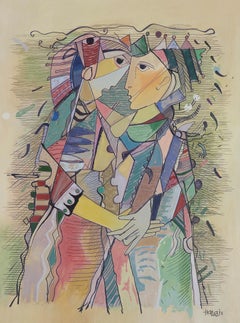Items Similar to Modernist Simon Samsonian, Two Sisters Mixed Media
Want more images or videos?
Request additional images or videos from the seller
1 of 8
Simon SamsonianModernist Simon Samsonian, Two Sisters Mixed Media1995
1995
$1,000
£759.66
€875.01
CA$1,430.60
A$1,568.99
CHF 809.19
MX$18,742.91
NOK 10,263.04
SEK 9,627.89
DKK 6,536.98
About the Item
Simon Samsonian (1912-2003)
Two Sisters, 1995
Poster color and mixed media on paper
Sight size: 16 1/2 x 14 3/4 in.
Framed: 26 x 23 1/2 x 1 in.
Signed lower left: Samsonian 1-1-95
Inscribed lower left: "Two Sisters" 1995 (Poster Color & Mixed Media)
Simon Samsonian was born in Samson, a small seashore town and seaport in North Turkey, the province of Trabizon. In 1915 it had a population of around 15 000, from which around one third were Armenians. The rest were Greeks and Turks.
We don’t know the precise birth date of Simon because later on he only remembered vaguely that at the beginning of the great genocide of the Armenians in Ottoman Turkey, in mid 1915, he was a 2-3 years old small child. So, we can only surmise that he was born during 1912-13. During the genocide most of the Armenian population perished, including of course Simon’s parents and relatives. However, he was fortunate to be rescued by a few years older sister named Hasmig, who ran away carrying him with her. Hasmig soon delivered her small brother to a line of children rescued by Greek nuns, but owing to the chaotic situation she disappeared from his life.
The nuns kept the small orphans with them for a few years, in a local orphanage, and when Greek troops occupied Izmir on May 15, 1919, they moved to that coastal city which was considered at the time to be a safer place to live. There Greek nuns in an orphanage who kept Simon with other children, named him Samsonian, after the town of Samson where he was born.
On September 9, 1922, Turkish republican troops invaded Izmir and in a few days put the Greek and Armenians quarters to fire. Now, ten years old Simon once again alongside other thousands, found temporary refuge in Constantinople (Istanbul), but within a year (on October 6, 1923) this city also fell to the Turks. This time the orphans were whisked away by American warships to a temporary orphanage site on the beautiful Greek island of Syra, found by the American Committee for Relief in the Near East, ACRNE (known as NER and created in 1918).
From October 1923 to August 1928, he at last enjoyed a peaceful childhood on the land of Hellas. Those were undoubtfully the most memorable days of his early life.
The second phase of Samsonian’s life began when he was transported to Egypt, and along with 32 other orphans temporarily lived on the top floor of Kalousdian Armenian National School at Boulaq, Cairo.
From 1932-1936 he studied art at the local Leonardo Da Vinci School, under the financial sponsorship of Kalousdian Alumni Association.
His first one-man show was held in 1936 at the Armenian Artistic Club, Cairo. Then he found a job in an Armenian printing house, meanwhile he became art teacher in Kalousdian Armenian National School (1936-1939). In 1939 he married to Lucy Guendimian, one of his students in Kalousdian. At once she became his lifelong friend and a best mother for their three children.
Beginning from 1937, Samsonian participated regularly in the annual saloons of Cairo. In 1945 he participated by 7 works in the first great exhibition of Armeno-Egyptian artists held in Cairo during March 25 April 15, at the Oriental Company of Publicity.
In the first half of March 1949 he exhibited 90 of his works at a gallery named Egypt-Europe. Critic Dikran Antranikian praised this exhibition, however speaking of some crudity in several works.
But the most important “event” in Samsonian’s artistic life occurred during the 1st half of 1950, when he visited Europe (Italy, Paris and London) to study the great artistic heritage of Western Europe. This journey changed his aesthetical conceptions drastically. However, he never fell under the direct influence of European great masters, (either classical or modern) and constantly guarded the originality of his art. Once back in Cairo, his Stylized Realism involved gradually to include elements of Fauvism and Cubism.
The years 1950-1968 are the most “brilliant” years in the life and artistic carrier of Samsonian. After around four “transitive” years (1950-1954), in 1955 an excellent work like the Portrait of Lucy, his wife, marks the beginning of his new style, which was more original and robust.
Now he was in the flower of his professional excellence, and starting from then on, he created a series of excellent works like Fellaha (Egyptian country girl, 1956), the Cello Player (exhibited in the second Biennale of Alexandria in 1957), The Resting Ballerina (1957), Young Girl at the Beach (1958), The Caliph Omar Ibn al- Khattab Praying in Jerusalem (1960). This last work was highly praised by both the public and artistic circles and is considered today one of the most important works in the modern Egyptian art. The Blind Man (1961), Reading at the Beach (1962), Rest (1963), The Student (1964), Tenderness (1967) etc.
In this period he regularly participated in many group exhibitions in Cairo and Alexandria. Like most annual saloons of Cairo, the first three Biennales of Alexandria (1955, 1957, 1959). The four group exhibitions of Armeno-Egyptian artists held in Cairo (1945, 1958, 1962) and Alexandria (1953) etc.
However, “the crown” of Samsonian’s artistic activities in Egypt was his third solo exhibition held in Cairo, at the galleries of the Society of the Friends of Art (Societe des Amies de l’Art). This exhibition was held during 11 to 22 January, 1961.
Samsonian exhibited 41 paintings created during the last decade. Critic Jean Moscatelli highly praised this exhibition in an article published in Le Progres Egyptien (14 January 1961). He mentioned specifically the well-balanced and strong compositions of Samsonian’s works.
In the spring of 1964, the artist’s painting titled The Student, won the first prize in the Salloon of Cairo. As a reward he was sent on a paid journey to Europe by the Egyptian Ministry of Culture. He visited (for the second time in his life) Paris and London, studying the latest innovations in plastic arts in 1965 and 1967. Thus, Samsonian became the most celebrated Armeno-Egyptian artist in the history of the twentieth century art of Egypt.
In 1965 and 1967 he also won the first prize in the Saloons of Cairo. Thus, he became the most celebrated Armeno-Egyptian artist (excepting Ashod Zoryan) in the history of the 20th century Egyptian art.
1968 was a crucial year for Simon Samsonian. In this year, in order to join his son Hagop and elder daughter Sona who had migrated to America few years earlier, he also left Egypt with his wife and younger daughter Hilda and moved to New York.
On their way to USA they stayed 2 months, May and June, in Athens. In the first half of June, Samsonian held in Athens, a solo exhibition of his works, exhibiting 14 oil paintings and 24 water colours, sponsored by Australian Qantas airways.
This was his fourth private exhibition, which was highly praised by the Greek media, including Ethnos, the largest newspaper, and a critic named Panaiotopoulos considered this exhibition “the best cultural event of the year”.
After many years we can consider this exhibition as a spontaneous act of gratitude to the country which hosted Samsonian (and around 20 000 orphans from both sexes) more than 40 years ago.
In New York, where his children had established previously, he abruptly found himself in a totally different social and cultural environment. However, being enthusiastic he was highly active during the early phase in America.
In his 1st year in New York (1968), his solo exhibition was held in the gallery of the Armenian Benevolent Union. It was natural that he exhibited only works created in Egypt. In 1969, his second solo exhibition was held in the Canadian city Toronto, at KAR galleries. Then in January 1972 a third solo exhibition was held in the Lynn Kottler galleries in Madison Avenue New York. Also in the same year the Art Committee of the City University of New York organized his 4th private exhibition in the new world.
In 1973, his “greatest dream” was realized. He visited Armenia (for the first and last time) accompanied by his wife, and held in the capital Yerevan, a retrospective exhibition of his works.
In 1988, the Armenian General Benevolent Union published in New York an album presenting his life and art. However, since then on he gradually lost interest in promoting his art in New York galleries, and lived a quiet life, being satisfied by creating works of art from time to time, till his death which occurred in November 4 2003.
Samsonian lived around ninety years. His life was full of dramatic events and joyful achievements, especially during his second life period in Egypt. But in USA after around a decade of a highly productive phase when he had already created some of his best works, like in the Subway (1970), The Girl in the Balcony (1971), Mother and Child (1973), Lady with Guitar (1974), and some beautiful still life-s, his art began to lose its usual strength of composition and depth of expression, and his paintings tended to become “flat” and decorative.
This was probably because of being disappointed and frustrated in America, when he found his artistic preconceptions quite alien to the dominant artistic trends there, where such non-figurative artists like De Kooning and Pollock were highly praised.
A posthumous exhibition of Samsonian’s works was held by the Armenian Museum of America (AMA) in New England, during September 29 until November 8, 2013, under the subtitle A Master Rediscovered, at Adelle and Haig Der-Manuelian Gallery.
Bio sourced from Armenian General Benevolent Union Egypt
- Creator:Simon Samsonian (1912 - 2003)
- Creation Year:1995
- Dimensions:Height: 26 in (66.04 cm)Width: 23.5 in (59.69 cm)Depth: 1 in (2.54 cm)
- Medium:
- Movement & Style:
- Period:
- Condition:
- Gallery Location:New York, NY
- Reference Number:Seller: BM41stDibs: LU2211215382442
About the Seller
5.0
Vetted Professional Seller
Every seller passes strict standards for authenticity and reliability
1stDibs seller since 2022
98 sales on 1stDibs
Typical response time: 2 hours
- ShippingRetrieving quote...Shipping from: New York, NY
- Return Policy
Authenticity Guarantee
In the unlikely event there’s an issue with an item’s authenticity, contact us within 1 year for a full refund. DetailsMoney-Back Guarantee
If your item is not as described, is damaged in transit, or does not arrive, contact us within 7 days for a full refund. Details24-Hour Cancellation
You have a 24-hour grace period in which to reconsider your purchase, with no questions asked.Vetted Professional Sellers
Our world-class sellers must adhere to strict standards for service and quality, maintaining the integrity of our listings.Price-Match Guarantee
If you find that a seller listed the same item for a lower price elsewhere, we’ll match it.Trusted Global Delivery
Our best-in-class carrier network provides specialized shipping options worldwide, including custom delivery.More From This Seller
View AllFauvist Pastel by Iranian American modernist Simon Samsonian
Located in New York, NY
Simon Samsonian (1912-2003)
Untitled, 1991
Poster color and pastel on paper
Sight size: 19 1/2 x 14 3/4 in.
Framed: 28 1/4 x 22 1/4 in.
Signed lower le...
Category
1990s Abstract Abstract Drawings and Watercolors
Materials
Paper, Pastel
Marion Maas Modernist Painting of Two Women
Located in New York, NY
Marion Maas (American, b. 1930)
Peggy - Brown + Gray, c. 1980s
Oil on canvas
Framed: 24 1/8 x 30 1/8 x 1 1/2 in.
Signed lower right
Titled verso on stretch...
Category
Late 20th Century Contemporary Figurative Paintings
Materials
Canvas, Oil
Samson Schames Abstract Work on Paper, 1960
By Samson Schames
Located in New York, NY
Samson Schames (German-American, 1898-1967)
Untitled, 1960
Mixed media on paper
Sight: 16 1/2 x 14 in.
Framed: 27 1/2 z 22 1/2 x 1/2 in.
Signed and dated lower right
Samson Schames ...
Category
1960s Modern Abstract Paintings
Materials
Mixed Media
Gorgeous Abstract Expressionist Figures by Syril Frank
Located in New York, NY
Syril Frank (American, 1929-2021)
Untitled, c. 1970s/80s
Oil on canvas
Framed: 21 3/4 x 25 2/3 x 1 in.
This fantastic painting in the abstract expressionist style loosely depicts a ...
Category
Late 20th Century Abstract Expressionist Abstract Paintings
Materials
Canvas, Oil
Original Lazzaro Donati Painting of an Abstracted Woman
By Lazzaro Donati
Located in New York, NY
Lazzaro Donati (Italian, 1926-1977)
Untitled (Abstract Woman), Mid-20th Century
Oil on board
20 x 16 in.
Framed: 25 3/4 x 21 7/8 in.
Signed lower right
Lazzaro Donati (1926-1977) was born in Florence in 1926 and attended the Academy of Fine Arts. He began to paint in 1953, and in 1955 held his first exhibition at the Indiano Gallery in Florence. Within three years eleven exhibitions followed in Italy, and as his reputation grew he was invited to give major exhibitions in London, Paris, New York, Chicago, Rio de Janeiro and Montevideo. He is considered one of the foremost contemporary Italian painters and his paintings hang in museums and private collections throughout the Americas, Europe and Asia.
Mr. Donati lived and worked at 24 Piazza Donatello in Florence, the square where generations of artists have created works worthy of the great Florentine tradition. As you entered the narrow hallway to his studio, a gilded life-size Venetian angel beckoned you to his door. Once inside, the present faded away and you found yourself in an atelier where early masters might have worked during the Renaissance. Within, luxurious Persian rugs set off the innumerable objects d'art and antique furnishings. Light poured in through the sloping glass wall on the north side. A dramatic stairway led to an overhanging balcony which served as a private gallery where the artist hung some of his favorite early works. To the left of the entrance was a smaller studio where Donati sculpted, with a window overlooking the famous old English cemetery where tourists laid flowers on the grave of Elizabeth Barrett Browning.
In the main studio itself, where Donati received his clients in an atmosphere as polished as an office of a top executive, one hardly realized that it was here that the artist actually painted. His easel was covered with Persian blue velvet, the painting on the easel was already framed, his chair was upholstered in red velvet and on his palette the colors were arranged with the precision of a Byzantine mosaic. In a corner stand were his latest works, framed and ready to be sent off to his next exhibition in Europe or America.
Donati was a born host with a warm welcome, an elegant man who possessed enormous charm a good nature and a keen sense of humor. Apparently shy, he preferred to speak on subjects extraneous to his art, purposely distracting you from his paintings, then leading you back to them, tactfully and without pretension. He spoke fluent French and English as well as some Spanish and German. "After all", he said, "you've got to know how to sell a painting to everyone."
He had no sympathy for the "drip and splash" studios of his contemporaries, preferring to keep his studio tidy and spotless. "Painting is a matter of precision", he said, "If a painter can't put his paint where he wants it to go, I don't see how he can call himself a painter. For me it is absolutely necessary to control the paint."
When asked to reveal the technique he used to achieve the enamel-like finish typical of his paintings he answered, "That is a secret between me and my butler. Actually, most of my paintings are done by him!"
But in fact behind the façade, Donati was a serious craftsman who devoted to his painting as a way of life and means of expression. From the beginning of his career, his paintings revealed a striving for perfection and continual research in problems of style and technique. His early works indicated a momentary interest in surrealism and abstract art; they were predominantly two dimensional, depending on line and strong color. But by 1958, with his painting The Lady with a Fan...
Category
Mid-20th Century Modern Abstract Paintings
Materials
Oil, Board
Vibrant Modernist Abstraction by Claire Burch
Located in New York, NY
Claire Burch (American, 1925-2009)
Untitled, 20th century
Oil on canvas
24 x 30 in.
Framed: 31 2/3 x 37 3/4 x 1 1/2 in.
Signed lower right: Claire Burch
After attending grade school in Brooklyn, Burch completed a commercial art course at Washington Irving High School in Manhattan and received her B.A. in English from NYU. In the suburbs of Great Neck, New York, she first began writing poetry and articles which were published in Life magazine, The New Republic, Mademoiselle, McCall's, Saturday Review, Redbook, Good Housekeeping, and numerous literary quarterlies and anthologies.[1] Burch also developed a career as a psychiatric writer, publishing two books on the subject: Careers in Psychiatry and Stranger in the Family.
In the early 1970s Burch became a playwright and painter. Her play Ten Cents a Dance was optioned to be directed by José Quintero, the famous O'Neill interpreter. Burch wrote a total of seven plays and several folk operas, but eventually moved on to filmmaking and video anthropology—she was an early adapter of video as a medium.
In 1978, Burch moved to California with her longtime companion Mark Weiman, publisher and owner of Berkeley's Regent Press. She had endured a series of illnesses and wanted to escape the harsh climate of Manhattan.
Burch gained insight and inspiration from insanity and the often unexpected behavior associated with it. She would often videotape homeless people in People's Park and Telegraph Avenue in Berkeley, which were collected in her film People's Park in Berkeley: Then and Now. The film documented the dispute between homeless activists and the University of California from the riots of 1969 through 1996 by interviewing park "regulars," and profiling the events surrounding the deaths of park supporters James Rector and Rosebud Denovo.[2]
She also produced documentaries on noted cultural figures such as James Baldwin (whom she knew as a teenager), Timothy Leary and Country Joe McDonald. Also of note was Oracle Rising, a film about the legendary psychedelic newspaper The SF Oracle published in the Haight-Ashbury district during the Summer of Love. Her last completed film was Elegy for the Naked Guy...
Category
20th Century Abstract Expressionist Abstract Paintings
Materials
Canvas, Oil
You May Also Like
"Colorful Geometric Abstraction, " Simon Samsonian, Armenian Artist
Located in New York, NY
Simon Samsonian (1912 - 2003)
Colorful Geometric Abstraction, 1981
Oil on paper
16 x 22 inches
Signed and dated lower right
Provenance:
Estate of the artist
This survivor of the Armenian genocide wound up in a Cairo orphanage in 1927. He rose to fame as one of Egypt’s great modernists, but after moving to Long Island late in life he withdrew into anonymity. Now his compelling story is being told. Art historians are finally beginning to realize that the power of abstraction in its early years was a zeitgeist not limited to the major European centers of the avant-garde — Paris, Munich, and Moscow — but one that quickly rippled to major cities throughout the world. Within a few decades that original shock of a new vision had inspired thousands of artists from different cultures — particularly those the Middle East — whose translations were not slavish imitations of works by seminal figures like Picasso, Braque, Malevich, and Kandinsky but creative variants colored by their respective cultures.
This essay focuses on an extraordinary Armenian artist, his harrowing survival of the genocide, his rise to fame in Cairo, and his creation of a unique style of abstraction. Art historians have typically formed a chorus that teaches the history of abstraction like this: Just before and during the World War I era, several avant-garde artists emerged to create shockingly different new forms by which artists could express themselves. In Paris, Picasso and Braque broke out with cubism, quickly followed by Mondrian. In Moscow, Malevich created Suprematism, the ultimate hard-edge geometric abstraction. And in Munich, Kandinsky emerged as the father of Abstract Expressionism. Within these few short years a zeitgeist was sensed throughout the art world. American pioneers, too — particularly Stanton Macdonald-Wright and Morgan Russell — felt this explosive freedom of expression. When Europe was recovering after World War I it became clear that Paris would retain its title as capitol of the art world, lasting through the Roaring Twenties and even through the Great Depression. But the end of World War II changed everything. A parallel war had been won by a group of irascible young Abstract Expressionists in New York — led by Pollock, Rothko, DeKooning, and Kline. No sooner had Paris been liberated from the Germans than Picasso, Matisse, Breton, and Duchamp surrendered to the Americans. From that point on New York would be the epicenter of the art world.
But a lens that focuses myopically on the war between the avant-garde of Paris and New York misses the wider narrative of multiple aesthetic modernities that developed in the several decades following World War I. For Armenian artists the matter is even more complex owing to the genocide of 1915 where more than 1.5 million people — seventy-five percent of Armenians in the Ottoman Empire — were massacred. Those not shot on the spot were sent on death marches through the Mesopotamian desert without food or water. Frequently, the marchers were stripped and forced to walk naked under the scorching sun until they dropped dead.
As a child Samsonian witnessed the murder of his parents and most of the members of his family. Soon thereafter, his older sister, Anahid, quickly shepherded him into a line of children being rescued by Greek nuns. But they became separated and he lost her, too. He was sent to a Greek orphanage in Smyrna (now Izmir), on Turkey’s west coast. Because he only knew his first name, the orphanage gave him a last name based on the place where they found him — Samsun — a major port on Turkey’s north coast on the Black Sea. His birth date was unknown, too. According to Samsonian’s vague recollections he assumed he was about three or four years old at the onset of the genocide, which would place his birth year in 1911 or 1912. In 1922, when Samsonian was about 10, the Turks ended their war with the Greeks by putting Smyrna to the torch in what has been called the “Catastrophe of Smyrna.” Once again, the child was on the run, escaping the fire and slaughter. He found temporary refuge in Constantinople, but within a year that major port would fall to the Turks, too, and become renamed as Istanbul. This time, Samsonian was whisked away to an orphanage in Greece founded by the American charity, Near East Relief — which is credited with saving so many Armenian orphans that the American historian Howard M. Sachar said it “quite literally kept an entire nation alive.
Any understanding of Samsonian’s approach to modernism requires careful consideration of the impact of his early years because his art is inseparable from the anguish he experienced. In 1927, when he was a teenager, he was transferred to Cairo, Egypt, then a cosmopolitan city hosting a sizable portion of the Armenian diaspora. There he lived with thirty-two other children on the top floor of the Kalousdian Armenian School. Upon graduating in 1932 he won a scholarship to attend the Leonardo da Vinci Art Institute — an Italian art school in Cairo — where he won first prize in final examinations among one hundred students. He found work with an Armenian lithographic printer and he returned to the Kalousdian Armenian School to teach drawing. In 1939 he married one of his students, Lucy Guendimian.
The Cairo in which Samsonian matured as an artist was home to many prominent art collectors after World War I. In this receptive environment Samsonian exhibited widely and won many awards. Beginning in 1937 and for the next thirty years he exhibited annually at the prestigious Le Salon du Caire hosted by the Société les Amis de l’Art (founded in 1921). After World War II he hit his stride as a modernist in Cairo, counting among his peers other artists of the Armenian diaspora such as Onnig Avedissian, Achod Zorian, Gregoire Meguerdichian, Hagop Hagopian...
Category
1980s Abstract Geometric Abstract Drawings and Watercolors
Materials
Paper, Oil
Contemporary figurative art portrait of two women oil pastels on paper "Sisters"
Located in VÉNISSIEUX, FR
This contemporary figurative piece with abstract touches, depicting two women, was created by French artist Natalya Mougenot. Through her dynamic approach, Mougenot explores the intr...
Category
2010s Abstract Expressionist Figurative Paintings
Materials
Paper, Oil Pastel
Two Women - Oil Painting by Sebastiano Sanguigni - 1999
Located in Roma, IT
Oil on canvas realized by Sebastiano Sanguigni (1931-2012).
Hand signed.
Very good condition.
Category
1990s Contemporary Figurative Paintings
Materials
Oil
Friendship, Contemporary figures.
Located in La Canada Flintridge, CA
Samuel Hallaj (1958-2024)
Samuel Hallaj was a visionary Armenian artist whose work transcended borders, captivating audiences around the world with its p...
Category
21st Century and Contemporary Abstract Expressionist Figurative Paintings
Materials
Oil
"Two Figures, " Louis Stone, Abstract, American WPA Modernism
By Louis Stone
Located in New York, NY
Louis K. Stone (1902 - 1984)
Two Figures, 1980
Mixed media on paper
Sight 52 x 42 inches
Signed and dated lower right
Louis King Stone was born in Findlay, Ohio in 1902 and received...
Category
1980s Abstract Abstract Paintings
Materials
Paper, Mixed Media
UNTITLED ABSTRACTION
By Rolph Scarlett
Located in Portland, ME
Scarlett, Rolph (American, born Canada, 1889-1984). UNTITLED ABSTRACTION. Colored pencils on paper, not dated. Signed, lower right. 5 5/8 x 8 1/4 inches (image), 6 x 8 3/4 inches, (s...
Category
Mid-20th Century Abstract Drawings and Watercolors
Materials
Color Pencil
More Ways To Browse
Early 20th Century Childrens Portrait
Impressionist Portrait Of A Young Girl
Lucy Vintage
The Nun
Abstract Art 22 X 40
Modernist Pastel
Young Ballerinas
Vintage Beach Girls
Sisters Impressionist Painting
Girls At The Beach
Red Skelton Paintings
Robert Healy
Theadius Mccall
W Mcgregor
Chinese Pith Album
Dewitt Hardy
Don Bachardy Drawings
Dorothy Hepworth
